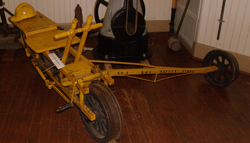 In October 1996, the Louisville & Nashville Railroad donated the museum’s velocipede. The Velocipede is propelled by one person and has a seating capacity for two, enabling the driver, or official, to bring along a section hand or another official. A velocipede is railroad incarnation of early bicycles and tricycles.
In October 1996, the Louisville & Nashville Railroad donated the museum’s velocipede. The Velocipede is propelled by one person and has a seating capacity for two, enabling the driver, or official, to bring along a section hand or another official. A velocipede is railroad incarnation of early bicycles and tricycles.
The Boyles Yard Lamplighter
This velocipede is said to have been used at Boyles Yard in Birmingham by the lamplighter. At that time, kerosene lanterns indicated the direction of switches in the yard, swinging from red to green depending on position - red for the diverging route and green for the main route. The lamplighter was in charge of making sure the switchlamps were fueled and lighted. He used the velocipede to travel the miles of yard trackage, carrying a can of kerosene on the back platform and new wicks in a little box between the frames in front. If he met a train he would merely lift the velocipede off the track, let the train pass, place the velocipede back on the track and continue his duties.
Human Powered
The vehicle is set into motion by a rowing motion and auxiliary, foot pedal-power. The frame, wheels and outrigger are wooden with the frame being held together by bolts. The outrigger has an iron brace to give it greater stiffness. The axles and crankshaft are made of iron and the tires are made from cast iron. The crank and pedals are made of malleable iron. The outrigger is adjustable and removable. The entire Velocipede weighs about 140 pounds, making it light enough for one man to lift the vehicle off the rails or turn it in the opposite direction.
Velocipede Manufacturers
A number of manufacturers supplied Velocipedes to the railroads. The Sheffield Company of Three Rivers, Michigan was the first in 1878, when founder George Sheffield saw the potential in selling Velocipedes with flanged wheels to railway companies. The Kalamazoo Railway Supply Co. of Kalamazoo, Michigan went into production in the early 1880's and manufactured some of the finest Velocipedes ever made for rail usage. The manufacturer of the velocipede at the museum is not clear.


